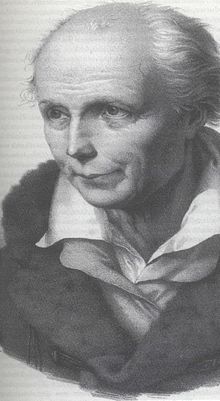Konrad Mannert
Konrad Mannert (born April 17, 1756 in Altdorf near Nuremberg ; † September 27, 1834 in Munich ) was a German historian and geographer.
Konrad Mannert was the son of the barber and surgeon Johann Heinrich Mannert. As a child he attended the town school of Altdorf and then the school of St. Sebald in Nuremberg . In 1778 he took up his studies at the University of Altdorf . In 1783 he became a master. From 1784 he worked as a teacher at the Sebalder School, from 1786 as a teacher and librarian at the Egidiengymnasium in Nuremberg. In March 1797 he was given the position of full professor for history and oriental languages at Altdorf University. In 1803 the Homann'sche map office in Nuremberg gave him the scientific management. In this publishing house he brought out numerous maps. The arrangement seems to have expired around 1807. In 1805 he went to the University of Würzburg as a professor . In 1807 he moved to the new Bavarian Central University in Landshut as a professor of history and geography, and then in 1826 he moved with the university to Munich . In 1827 he became a full member of the Bavarian Academy of Sciences and in 1828 he retired.
His works are particularly characterized by a thorough study of the sources. His monumental major work on the geography of the Greeks and Romans , on which he worked almost his entire life, was of particular importance for the study of antiquity . This work received a special reception from the German writer Arno Schmidt (1914–1979), who drew much of his knowledge of the ancient world from it, which he used for stories such as Kosmas or Vom Berge des Nordens . Schmidt thanked him by mentioning Mannert on various occasions, for example in Brand's Haide , where he said, “Konrad Mannert: I thank you, I owe you a lot of knowledge: why do the Wilhelmsaffen have monuments and not Konrad Mannert? ! ”Appreciated.
Mannert was married to Ursula Jacobina Nagel, a daughter of the theologian Johann Andreas Michael Nagel .
Fonts
- History of Bavaria , Leipzig 1826, 2 volumes
- Compendium of the German Imperial History , Nuremberg 1803
- Oldest history of Boyaria , Sulzbach 1807
- Emperor Ludwig IV. , Landshut 1812
- History of the old Germans, especially the Franks , Stuttgart 1829–1832, 2 parts
- Geography of the Greeks and Romans , Nuremberg 1788–1825, 14 volumes
- Tabula Peutingeriana , Munich 1824
cards
- The Bavarian monarchy. Designed in two sheets by Conrad Mannert. Christian M. Trummer sculpsit. [Approx. 1: 610,000]. Nürnberg, by Christoph Fembo 1824. Copper engraving in 3 parts mounted on a sheet
- The Bavarian monarchy. [Dedicated] King Maximilian Ioseph I of Bavaria. Designed in two sheets by Conrad Mannert. CM Trummer sc. After the new division, expanded and corrected edition. [Approx. 1: 610,000]. Nuremberg, Christoph Fembo, formerly Homann's heirs 1819. With 1 side card: Supplement to Mannert's chart of Bavaria: the Rhine district. Secondary title: Road map of the Kingdom of Baiern according to the highest regulations on the division of roads
literature
- F. Loschge: Conrad Mannert. Life and work of a Nuremberg scholar in Franconia and Old Bavaria . Inaugural dissertation of the Philosophical Faculty of the Friedrich-Alexander University Erlangen-Nürnberg 1968.
- Franz Xaver von Wegele : Mannert, Konrad . In: Allgemeine Deutsche Biographie (ADB). Volume 20, Duncker & Humblot, Leipzig 1884, p. 199 f.
- Konrad Mannert . In: Theodore von Wallmenich; Josef H. Biller: List of ancestors Clementine von Wallmenich (1849-1908) . In: Leaves of the Bavarian State Association for Family Studies , 73rd year. 2010. p. 130 f.
Web links
- Short biography of Mannert in the astronomy portal Nuremberg
- Short biography of Mannert among the memory data 2006 of the Nuremberg City Archives
- Article Mannert in Meyers Konversations-Lexikon, 1885-1892
Remarks
- ^ Arno Schmidt, Brand's Haide [1951], in: Arno Schmidt, works. Bargfelder Edition , Volume I / 1, Haffmans Verlag, Zurich 1987, pp. 115–199, here p. 163. On Schmidts' Mannert reception cf. especially Dieter Kuhn, Mannert: I thank you. About a source for Arno Schmidt's "Kosmas" , in: Bargfelder Bote , Liefer 134-136, March 1989, pp. 4-33.
| personal data | |
|---|---|
| SURNAME | Mannert, Konrad |
| ALTERNATIVE NAMES | Mannert, Conrad |
| BRIEF DESCRIPTION | German historian and geographer |
| DATE OF BIRTH | April 17, 1756 |
| PLACE OF BIRTH | Altdorf near Nuremberg |
| DATE OF DEATH | September 27, 1834 |
| Place of death | Munich |



